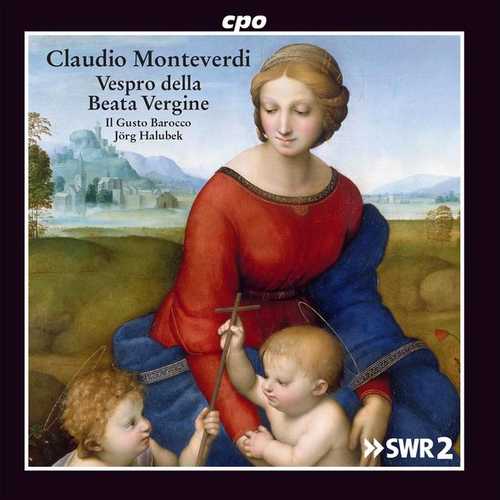
Composer: Claudio Giovanni Antonio Monteverdi
Performer: Alena Dantcheva, Natasha Schnur, Andrea Gavagnin, Ophelia Klumpp, Jakob Pilgram, Michael Romer, David Szigetvari, Johannes Weiss, Lisandro Abadie, Geoffrey Buffiere, Il Gusto Barocco
Orchestra: Stuttgarter Barockorchester
Conductor: Jorg Halubek
Format: FLAC (tracks)
Label: CPO
Catalogue: 555314-2
Release: 2021
Size: 370 MB
Recovery: +3%
Scan: yes
Vespro della Beata Vergine, SV 206
01. I. Domine ad adiuvandum me festina
02. II. Dixit Dominus
03. III. Nigra sum
04. IV. Laudate pueri dominum
05. V. Pulchra es amica mea
06. VI. Laetatus sum
07. VII. Duo Seraphim clamabant
08. VIII. Nisi Dominus
09. IX. Audi coelum
10. X. Lauda Jerusalem
11. XI. Sonata sopra “Sancta Maria, ora pro nobis”
12. XII. Ave maris stella
13. XIVa. Magnificat
14. XIVb. Magnificat. Et exultavit
15. XIVc. Magnificat. Quia respexit
16. XIVd. Magnificat. Quia fecit
17. XIVe. Magnificat. Et misericordia eius
18. XIVf. Magnificat. Fecit potentiam
19. XIVg. Magnificat. Deposuit potentes de sede
20. XIVh. Magnificat. Esurientes implevit bonis
21. XIVi. Magnificat. Suscepit Israel puerum suum
22. XIVj. Magnificat. Sicut locutus est
23. XIVk. Magnificat. Gloria Patri et filio
24. XIVl. Magnificat. Sicut erat in principio
There are indeed many recordings of Monteverdi’s Vespers of the Blessed Virgin, but the special thing about this particular recording is that it was produced following the performances of a scenic interpretation with the Spanish stage director Calixto Bieito. What now follows is a musical exploration forming a sequel to scenic occupation with the Vespers.
Since 2017 Il Gusto Barocco has been the guest ensemble for the four-part Monteverdi cycle initiated by opera director Albrecht Puhlmann at the Mannheim National Theater. From the musician’s perspective, the scenic exploration of music rooted in the liturgy does in fact clearly differ from a performance during a religious service or a non-scenic concert performance. During the time-intensive process prior to the staging of an opera, scenes, images, and figures gradually take shape. In each stage figure the quest is for an emotional truth from which her or his artistic nature, aesthetic character, and credibility result – and ultimately word and tone, in order to produce empathy and engage the public.
Another important aspect of this recording is the great number of diminutions in all the instrumental and vocal parts, all of which were improvised at the particular moment. During the shared scenic preparation for the opera stage, the individual movements of the Marian Vespers obtained a definite emotional space in the dramaturgical sequence. Accordingly, sections and their basic characters were defined and invented at the particular moment for each performance and for this recording.